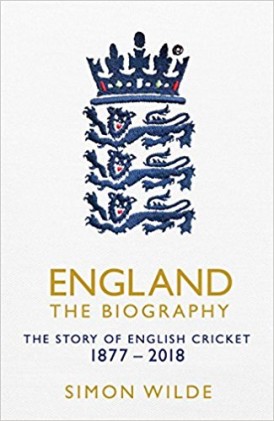England: The Biography
Martin Chandler |Published: 2018
Pages: 614
Author: Wilde, Simon
Publisher: Simon and Schuster
Rating: 4 stars

Simon Wilde, cricket correspondent of the Sunday Times since 1998, is a fine writer, and certainly not a man to shirk a challenge. In the past he has had the courage to write biographies of two of the most enigmatic players of the early noughties, Shane Warne and Kevin Pietersen, as well as English cricket’s greatest national treasure, Sir Beefy himself. Having read all three I am struggling to understand why only the Botham has a review on CricketWeb, particularly as I recall to this day being fascinated by the highly original opening chapter of Shane Warne: Portrait of a Flawed Genius, the story of an imagined confrontation with the great bowler.
All three of Botham, Warne and Pietersen have played out their careers in Wilde’s lifetime, and indeed the latter two during his tenure as a writer. Perhaps books about modern greats require a different skill set, or at least a different approach, to writing about men and events from the past where a life has a beginning, a middle and an end. Wilde can certainly do that too however, as he did in his first book, a biography of Ranji that was published back in 1990. That one was rightly acclaimed as the definitive story of a complex life, and the three years he spent researching it is, perhaps, part of the reason why Wilde chose, subsequently, not to delve too far back into the past.
Our man clearly missed the challenge though, as his long awaited ‘biography’ of England’s Test cricket must have consumed his life in recent years. Ranji’s life was, unusually for a cricketer, a notable one throughout his journey from cradle to grave, a matter of sixty years. But English cricket has been going now for much longer than that, in excess of one hundred and forty years, and has had an existence with even more twists, turns and intrigue than the Prince of the Golden Age. Is it possible to do justice to that story in 614 pages?
Literally millions of words have been written on the subjects that Wilde covers, many of which he has no doubt read. The story is as well told as would be expected, and those who know it already will still enjoy being reminded of how England’s Test cricket got to where it is today, and there will be very few who do not learn something they were not previously aware of. For those unfamiliar with the detail Wilde’s narrative will hopefully tempt them to investigate further the lives and times of the men who feature in the early chapters, as well as the matches in which they played. The vast majority of these are chronicled in more detail elsewhere, albeit not always so well.
England: The Biography is, as anyone who has read Wilde in the Sunday Times over the years would expect, particularly strong in its examination of recent years. As the international game has become more complex, with additional participants and formats, it is often difficult to keep track of and any reader, such as this reviewer, whose knowledge is greater of the past than the present but whose enthusiasm covers both will be particular grateful for the latter part of the book.
The danger of a book such as England: The Biography is that it ends up being a gentle introduction to its subject that pleases no one. The student of the game learns nothing he did not know already, and the potential convert to cricket literature is simply not enthused by a story that is a slightly colourless history of men and matches from days gone by. That is not the case here however as Wilde’s story unfolds in a manner which will please all his readers. His writing is illuminated by the sometimes quirky tables of information that appear at the end of each chapter – the level of match fees and duration of tours are but two examples of the sort of information that usually takes a bit of work to uncover. I will also single out one of the shortest chapters in the book for a word of praise. On The Mat picks up on another of those subjects seldom dwelt on, and is a look at the matches England have played on wickets other than turf ones, 35 in South Africa and four in Trinidad – none, I was surprised to note, on the sub-continent.
If you have someone in the family who is interested in the history of England’s international cricket, but has not yet become addicted to the game’s literature then this is certainly a recommended gift. It will keep the recipient quite for several hours, always assuming of course that the donor can resist the temptation to cadge a look for themselves.






Leave a comment